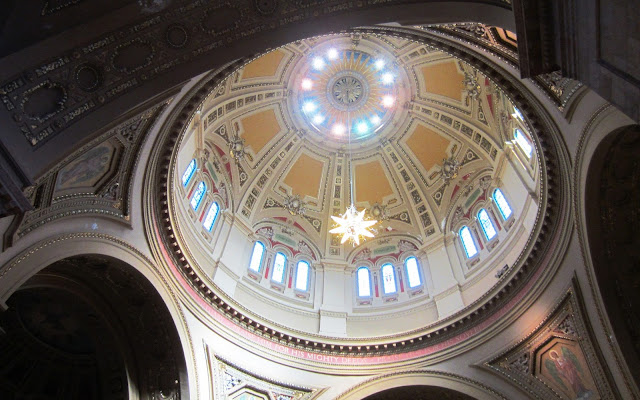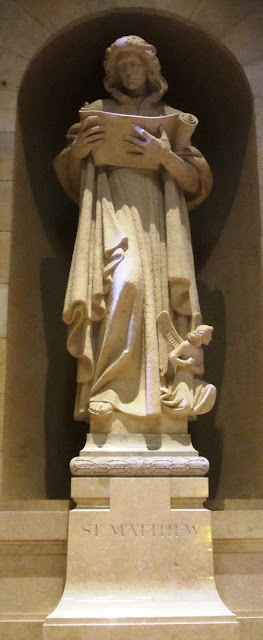Like its fraternal twin in Minneapolis, the Basilica of St. Mary, the Cathedral of St. Paul in St. Paul, Minnesota, was designed by Franco-American architect Emmanuel Louis Masqueray and built from 1906 to 1915. As was the case with the church in Minneapolis, work continued on the inside for many more years, and it wasn't considered complete until the last two rose windows were installed in 1941.
This stunning Classical Revival cathedral, considered by some to be Masqueray's magnum opus, sits on Summit Hill overlooking St. Paul and dominates the surrounding area. The 120-foot-wide dome is overlaid with copper, and the outside walls are granite from St. Cloud, Minnesota. At 306.5 feet high, this cathedral is the fourth tallest church in the United States
The architecture and engineering of a building like this are mind boggling to me.
I love the windswept angel who prays from the top of a nearby dome:
The window is lined with the Latin phrase "Euntes ergo docete omni gentes," or "Go ye therefore and teach all nations." Above the window, an ornate scene shows Christ sharing those words with ten of his apostles.
Peter and Paul peer down at visitors from their high perch on the cathedral wall. They don't look all that welcoming:
The airy, echoing interior can seat 3,000 worshipers, most having a pretty good view of the altar:
The high altar, based on a sketch by the highly acclaimed 18th century English architect Christopher Wren, was added in 1958:
The glowing golden dome over the altar draws the eyes upward:
None of my pictures of the magnificent pipe organ in the loft above the back door turned out, but Wikipedia had a great shot. This organ was built by the Aeolian-Skinner Organ Company in 1963:
The pipes surround the beautiful rose window. Here it is as seen from the inside:
. . . and from the outside:
One of the wonderful features of the cathedral is a full-sized replica of Michelangelo's Pieta, given to St. Paul's by a donor in 2010. As in St. Peter's Basilica in Rome where the original is located, this statue is in a chapel to the immediate right of the cathedral entrance. While it seemed more monochromatic and much less nuanced to me than the original, it was still a moving experience to see these figures:
A video made by the cathedral tells a little about the replica:
Other chapels and niches around the periphery provide many places for prayer and reflection.
As in most Catholic cathedrals, Mary is very prominent. A statue of young Mary with her mother St. Anne is very similar to one in the St. Mary Basilica in Minneapolis. Less frequently seen is St. Joachim, the father of Mary:
The Chapel of the Blessed Virgin Mary contains the sculpture Our Lady of Victory:
As in most Catholic cathedrals, Mary is very prominent. A statue of young Mary with her mother St. Anne is very similar to one in the St. Mary Basilica in Minneapolis. Less frequently seen is St. Joachim, the father of Mary:
The Chapel of the Blessed Virgin Mary contains the sculpture Our Lady of Victory:
A painting of Mary and Child looks a lot like Russian Orthodox iconography:
Here's Pope Benedict and Peter (with his giant key):
There are scenes from the life of Mary, including the annunciation and the birth of Christ:
. . . as well as the crucifixion of Jesus and Mary's assumption into heaven:
There are so many little intricacies:
The stations of the cross are especially nice in this cathedral, each a work of art in itself:
Another unique feature of St. Paul's Cathedral is a semi-circle of small chapels behind the altar that honor the patron saints of the six ethnic groups that settled in the St. Paul area.
St. Boniface, Patron of the Germans:
St. Therese of Lisieux, Patroness of all Missionaries:
. . . and Luke and John:
Two cities, two churches. We loved both buildings. It is a wonderful exercise in comparison-contrast.













































Lots of beautiful details in this church. I really like the Mary chapel, and that windswept angel is spectacular--although I think the halo looks a little too helicopter-ish. Thanks for the peek into two beautiful churches!
ReplyDeleteThe two huge cathedrals in St. Paul and Minneapolis are treasures. Unbelievable that they were built at the same time. I loved that this cathedral was seemingly built in a field. I love the emptiness that surrounds much of it.
ReplyDelete